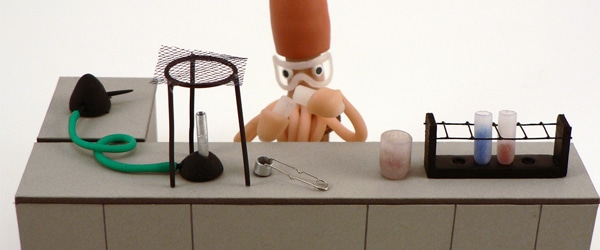When I was in school, I absolutely hated giving talks. I was a really nervous presenter, my heart would start beating faster, my face would go red, my hands would shake…even my voice would tremble! Since then I’ve made some big breakthroughs, and now I absolutely love giving talks and lectures. Here are my top seven tips for stress-free scientific presentations, so that your sweaty hands don’t get in the way of your scientific career.
1. Choose a Power Outfit
While you don’t want to overdress, it’s well established within psychology that dressing professionally not only impacts how your audience perceives you, but also your confidence and performance (E.g. The ‘white coat effect’).
Choose something you feel snazzy but comfortable in, but definitely don’t wear a brand-new outfit you’ve never worn before. I once ordered a blazer online so I could wear it to give an important talk. Turns out the sizing chart wasn’t super accurate and it restricted my arm movement quite a bit. What followed was what I can only describe as very awkward, because an authoritative persona can be undermined by looking like a T-Rex.
In a similar vein, if you’re a nervous presenter who tends to get sweaty, definitely don’t wear something that will show your sweaty armpits. I’m looking at you, grey/blue shirts!
Some more pointers: Comfortable footwear (always overlooked), and warm clothes (many people feel cold or have chills while nervous, so a jacket or cardigan should help avoid distractions).
2. Don’t Give Yourself Away as a Nervous Presenter (Body Language)
This is a big one. If you’re sitting in the audience of a talk, you’ll know immediately when a speaker feels uncomfortable and awkward. If they have their arms crossed, they are hunched over, they angle themselves away from the audience, or if they don’t make eye contact, you know they don’t want to be there. Even if it’s an interesting topic, it can become painful to watch.
It might seem overly simplistic, but there is psychological evidence that just smiling and standing up straight actually makes you feel happier and more confident, and this can become a feedback loop. So make sure that from the get-go you are standing up straight with your shoulders pulled back, avoid crossing your arms, angle your body towards the audience (not towards the slides), and smile.
Similarly, you can spot a nervous presenter from a mile away if their hands are shaking or if they have some other nervous habit. If the breathing techniques section below fails you, you might need to hold something for ‘stability’. Usually, this will be the laser pointer device that you use to click through slides, but if you don’t have one, just hold a pen.
If you do use a laser pointer, for the love of science, don’t overuse it. If your hands are shaking, the laser pointer will also shake, which is distracting and amplifies your nervousness. Gripping the edges of the lectern until your knuckles are white is also not a good look.
3. Switching off the Fight-Or-Flight Response
If you’re nervous, it means your fight-or-flight response (i.e. sympathetic nervous system) has been activated. You’re probably taking short, shallow breaths from your chest, which can quickly result in hyperventilation.
People who suffer from anxiety know what I’m saying! In order to relax, you need to activate your parasympathetic nervous system. The easiest way to do this is by taking slow, deep breaths into your lower lungs (hello, diaphragm!). There are a lot of online resources that can teach you how to breathe ‘properly’ but here is one breathing technique that’s particularly helpful, especially for those with anxiety.
One more thing about breathing: it sounds counter-intuitive, but if you’re on stage and you find yourself getting short of breath, just take a moment to fully exhale between sentences, instead of continually trying to fit more air into your lungs. Trust me.
4. Have a Good Laugh
The first and most significant breakthrough I ever had with public speaking was laughter. I’d been feeling really nervous in the lead-up to giving a talk at school one day, but I walked to the class with a friend and he made me laugh so much I literally forgot about how nervous I was. I did the talk and maybe it wasn’t the best talk ever, but I was smiling and relaxed.
It’s been proven that laughter has many benefits, including reducing stress and anxiety, and the effects of a good belly laugh can last for quite a long time.
So next time you’re freaking out before a talk, chat to someone you know can make you laugh, watch a funny YouTube video, or something similar. I would recommend that you check out this TedX talk on how to sound smart.
It may be tempting but try not to put too many jokes in your talk because it can be a bit awkward if the audience doesn’t laugh as much as you.
5. Warm Up (No, Really)
As I discovered when I was doing an early-morning radio interview, if you barely speak all morning and then try and give an in-depth talk on complex science, you will struggle to get the words out. You don’t need to sing scales or anything, just try and make sure you chat to people before the talk or talk to yourself in the car or in the shower or something – whatever works for you.
6. Practice, but Not the Way You Think
You might think that to totally nail a talk, you have to practice it over and over again until it’s perfect. This is true, but did you know that practicing it in your head is just as effective as practicing it out loud? This is called mental practice.
Studies of professional sportspeople, dancers, musicians, surgeons and stroke patients have shown that mental practice is highly beneficial and increases confidence. This is because overlapping areas of your brain are activated when you practice mentally vs. when you’re actually practicing. Mind = blown!
Practicing is a double-edged sword. Of course, you want to rehearse your talk, but if you rehearse it too much and have a ‘script’ memorized, it can sound robotic. It can also backfire because if you screw up one little bit of the script, it can cause a sort of domino effect and you can end up totally lost.
Personally, I find it’s best to take a ‘structured improvisation’ approach (dancers know what I’m talking about). Know your subject matter, take your cues from your slides, practice your transitions, but don’t rehearse a speech. That way it flows naturally but you won’t go off on any tangents.
If you’re not too worried about the talk itself, but getting caught off-guard during question time is your main fear, check out this article on How to Stop Worrying and Love Your Q&A Session.
7. Trick Your Brain
This was something I had been doing for years without realizing, but then I read about it in an article called The Silent Crowd by Sam Harris.
The emotions of excitement and nervousness are…almost exactly the same. Apparently, they also have the same physiological effects. Yet, one is positive and the other is negative, because of the psychological content we attach to them.
So, try to experience the butterflies purely as a physical sensation without attaching negativity to it.
Trick your brain into replacing anxiety with excitement. Remember that you love science and you’re excited about your research – that’s why you chose it for a career, and that’s why you want to give a talk about it. Your audience most likely loves science too and will be supportive.
Don’t forget that you’re not the only one who freaks out before a talk. Most brilliant public speakers out there were once just as nervous as you are!
Do you have any tips for giving a talk if you’re a nervous presenter? Leave your comments below.







